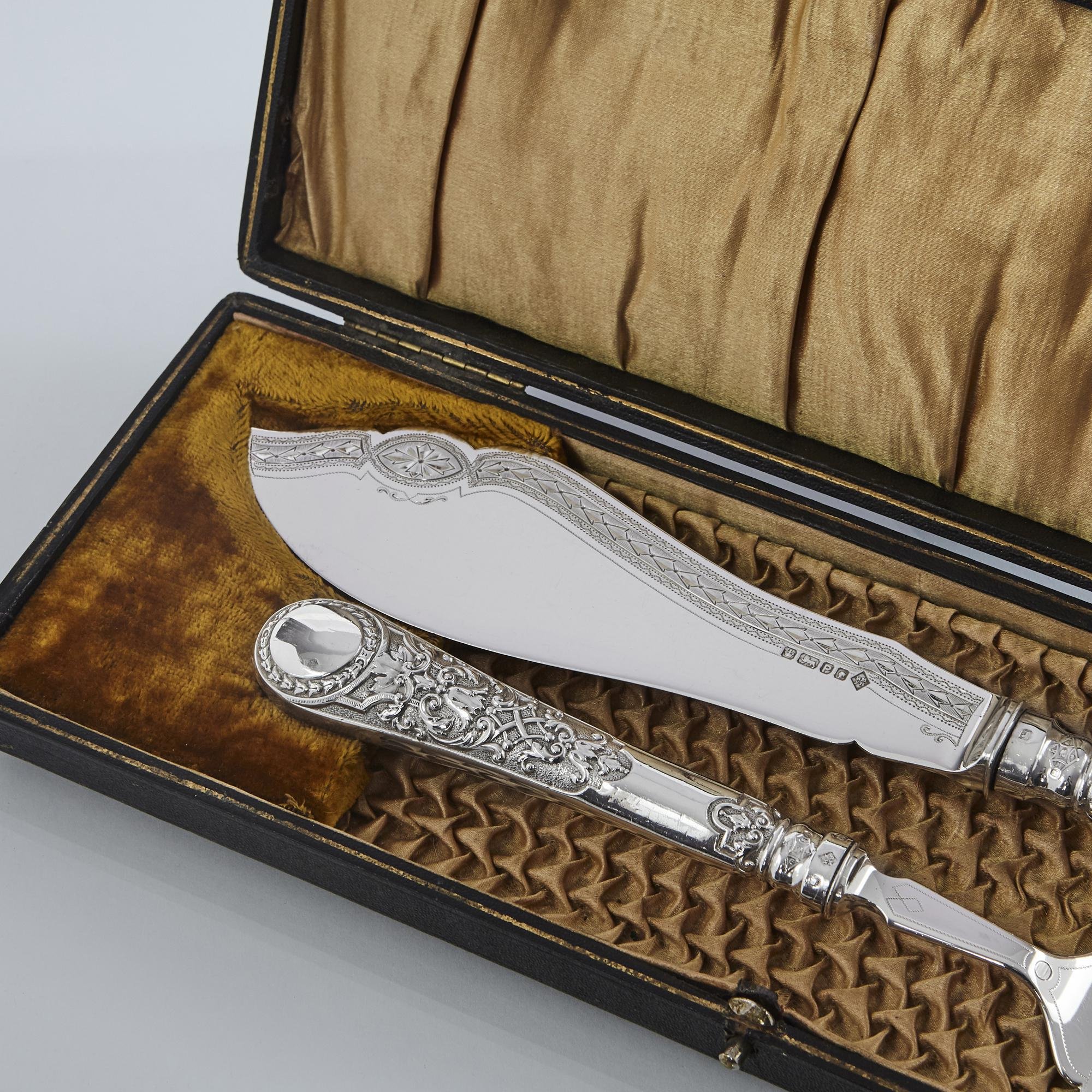Cut-throat or Cut-fish
4 August 2022
Some knives are meant for slicing, and others are destined for snobbery.
Francesca Peacock
Francesca Peacock is an art, books, and culture writer.
Pair of Victorian Venetian pattern silver fish servers, 1882, Sheffield.
Available from Langfords for £450.
There are few things more maligned in the cut-throat world of silverware than the humble fish-knife. Edward VII — nicknamed “The Playboy Prince” — may not have been very discerning about who he went to bed with, but he took the opposite approach to his dining table: there have been no fish knives in royal palaces since Bertie damned them as “very common”.
By 1958, when John Betjeman published his biting satire “How to Get on in Society”, things were hardly better for the poor little implement. His poem opens with the line “Phone for the fish knives, Norman”. “Fish knives” — like the words “phone”, “serviette”, and “toilet”, and even the name “Norman” — were decidedly “Non-U”. Whilst Betjeman was parodying the snobbery of these distinctions (Nancy Mitford’s joke-essay on U and Non-U language had been published in 1955), it is clear that only the social-climbing middle-classes could be grubby enough to aspire to a whole separate piece of cutlery for their fish course.
Even in our own enlightened age — when both Tatler and The Telegraph can go as far as to declare that “pardon” is now as aristocratically-acceptable as a loudly barked “what?” — the sorry spectacle of the fish-knife has still not been rehabilitated. “Fish knives will never be fine”, sniffed one commentator. After all, they really would lower the tone of one’s Ottolenghi baked salmon.
How did such a small implement come to cause such huge offence? Fish knives are not the oldest form of fish cutlery, with silver fish-servers dating from as early as the 1740s. It was only in the 1840s and 50s that they began to be manufactured. For the Victorian middle classes, dinner party vogue was for courses to be served separately rather than all at once. All of a sudden, vast services of cutlery were needed for each of the different food-types: fruit knives and forks, soup spoons, sugar tongs — you name it, the Victorians had it.
The fish knife’s creation was the pinnacle of fussy daintiness. Take this fine specimen in the V&A as an example. In the place of removing fish from the bone with two forks, diners now had a wealth of possibilities: a sharp, scalloped edge to remove the skin, a broad blade to lift the fish to the plate, and a sharp point to remove small bones. With all of these mod-cons, it is no surprise that brides would often ask for them on their wedding lists. Who wants jewels and treasures when you can eat your trout with mother of pearl cutlery handles?
But, despite their appeal — there are brilliantly engraved fish services with endless ornate patterns to choose between — fish-knives never really broke out of their middle-class strictures. It wasn’t just Edward VII who took against them. Debrett’s — that pinnacle of etiquette and snobbery — declines even to mention them: “at one time fish was correctly eaten with two forks”, they insist. Whilst normal knives and forks are “now … the accepted implements”, the poor fish knife doesn’t even get a look in.
Have fish-knives gone the way of 1970s avocado dishes and even — horror of horrors — the heated hostess trolly? To see if this really might be the case, I began an intrepid exploration of London’s antique silver dealers.
George V Sterling Silver & Mother Of Pearl Fish Set.
Hallmarked in Sheffield in 1935 by Viner's Ltd.
Available from I. Franks for £2,495.
Initially, I came up against sheer confusion. When asking about fish knives, I was met with a response more fit to an enquiry about buying one of Rasputin’s fingernails. “Fish knives?” “Yes.” “Knives to eat fish with?”. “Yes, really”, I replied, feeling more and more like I had accidentally committed the antiques offence of the year.
One major antique silver dealer didn’t fillet their words. The market for fish knives is a “disaster area”, with occasional sales only happening when the implements are sold as part of a larger cutlery service. The ban on selling ivory has not helped: the most ornate and decorative examples of fish knives are now illegal to trade. The market is as “dead” as the elephants who lost their tusks.
Other dealers were more quietly confident. Over at Langfords — one of the many silver dealers in London Silver Vaults — Adam Langford spoke about the “glamour” of a fish-service. With their delicate engravings and mother of pearl embellishments, they add “something special” to a table. And, he noted that some buyers appreciated this. Whilst the market is certainly not growing, he maintains it is “stable”. Just the other week, he sold a set of 24 fish knives and forks for £5,000.
Both Langford and Daniel Franks (of the antiques dealer, I. Franks) note that there will always be an interest in an antique if it is “something really good” — no matter its original purpose, or class snobbery. Franks drew attention to the more decorative sets — gothic and tudor patterns; engravings of fish — as being those that still sell. Nor do they sell cheaply: a fish knife and fork set could set the purchaser back between, on average, £1200 and £3000. And that’s before you factor in the cost of the damage to your social reputation.
But, for all the snobbery, there is something quite delightful about a fish knife: something so pointlessly fussy, and needlessly clutter-y. They are an antidote to an age of minimalism and sparse lines, and a brilliant “fish off” to the type of person who still carps on about their “common” credentials. So next time you’re having a dinner party, why not phone for the fish knives, Norman?































